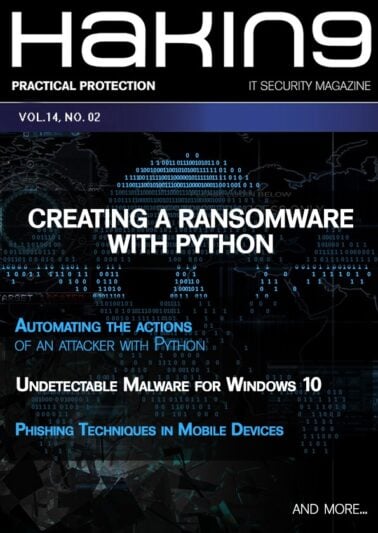No products in the cart.
Web Application Penetration Testing
$33.00
16 items sold
Get the access to all our courses via Subscription
Subscribe
Download
| File | |
|---|---|
| H9 Preview Web Application Penetration Testing.pdf |
Dear readers!
Easter is coming, so brace yourselves and take a look at our brand new issue. This time Hakin9 Magazine is completely focused on Web Application Penetration Testing. Are you ready? Then let’s go!
TABLE OF CONTENTS
Web Application Penetration Testing - Introduction
by Amit Kapoor
They say that life is too short to make all the mistakes yourself, and that you must learn from the experience of others. I believe that the vastness of knowledge also falls in a similar category. You simply cannot learn everything, and must acquire the knowledge of others. At times it is enough to refer to the masters for explanation of topics that have already been researched thoroughly.
Web Applications Penetration Testing Tools - Overview
by Andrea Cavallini
Nowadays, the world of information technologies, in particular the applications development process, is strongly oriented to web implementations. Cybersecurity is important because web languages have more attack vectors than the other languages; its aim is to guarantee the CIA Triad, with confidentiality, integrity, and availability milestones. Vulnerability assessments are necessary to know the level of criticality of the entire platform or of its components; Burp Suite is one of the most important tools for Web Application Penetration Test activities (WAPT).
Web Application Penetration Testing – Beyond Standard Tests
By Severin Wischmann & Rafael Scheel
Watching TV, gathering information, interacting with friends and family or buying groceries: the internet gains more and more functionality by the day. Putting a new service on the web becomes easier every day with simple scripting languages, such as PHP and JavaScript, as well as content management systems (CMS) that provide all the basic functionality. Given these possibilities only one question remains: are they safe to use?
Scanning Weaknesses With Google And NMap: Introduction To Scanning Phase And Tips On Google And NMap Usage
by Carlos Castro
In this introductory article, there is a description of what should be done at the scanning phase of an investigation and how to use a search engine like Google, and a utility like NMap, to help discover a system´s vulnerability. The approach that uses Google’s search engine will show how some vulnerable systems could be found with a combination of search operators. Furthermore, the NMap section will show how to check the vulnerabilities of a specific target.
How To Use OWASP ZAP PROXY For PenTesting Web Based Applications
by Cory Miller
The Open Web Application Security Project (OWASP) releases the top ten vulnerabilities found in web applications every year. Some of the items on the list are Cross-Site Scripting (XSS), SQL Injections, and Cross-Site Forgery(CSRF). These vulnerabilities continue to plague our web applications today. In order to protect against these vulnerabilities, Penetration Testers rely on tools which provide automated testing on web applications. To gain better visibility into web applications, a Penetration Tester can leverage the OWASP Zed Attack Proxy (ZAP).
Journey to Reverse Engineering - Unraveling Key To Software Reversing & Malware Analysis
by Samrat Das
Reverse Engineering is a lesser-known fascinating art. In simple words, Reversing is the art of stripping down software back to its source code in order to modify/inspect it. Reverse engineering cannot be defined in a couple of simplified lines, since, depending on interpretation, it is broad and diverse for different people. “Reversing can be termed as processes of examination wherein the original software system under consideration is not modified while explicit associated functionality and relations between components are investigated”.
How To Hack With SQLMAP - Performing SQL Injection
by Sumit Kumar Soni
SQL Injection is one of the top vulnerability in OWASP top 10. It has been around since the 1970s. Finding and exploiting SQLi needs a specialized skill set which requires deeper understating of web technologies, backend database and mechanism to retrieve data from DBMS, e.g. Structured query language (SQL). Over time, the techniques for exploiting SQL Injection have been improved. With the advent of programming languages, these techniques have been incorporated in the form of tools that can be used by naïve users.
Web Application Penetration Testing
by Gilles Lami
Web application penetration testing has become particularly important nowadays. Web applications, if not well secured, can offer attackers numerous ways to penetrate into systems and networks, or ways to steal sensitive data, even without getting a shell (command line) on the system. With the evolution of technologies, Web applications became more and more complex, using more and more components (the age of only using basic HTML is over), so the attack’s surface is greater and ways to attack these systems are numerous. We can see the impacts in the news, when a web application has been compromised, personal or sensitive data has been stolen and this information been made public.
Web Applications In The Modern World
by Hashem Ahmad
Today, a lot of our life actions are online; different kinds of shopping, Internet banking and financial transactions, social communication with our friends, TV shows, and a lot of universities are uploading their academic courses to the web. Examples are numerous, and the number of companies whose existence totally relies on web applications is increasing everyday; Facebook, Twitter, Ebay, Uber and many, many more companies that are nothing but a web application. That’s why the market today is paying close attention to protecting web applications and the underlying infrastructure, because it’s not just about service temporary interruption or data leakage; for some companies, an exploited vulnerability in their application could make them going
totally out of business.
Understanding SCAP Through a Simple Use Case
by Alexandre D’Hondt & Hussein Bahmad
Nowadays, one of the main concerns of IT personnel is security. Indeed, systems composed of various software pro-ducts must be configured, patched and monitored in compliance with organization’s security requirements. As complying with these requirements is a very expensive task, security engineers need a way to automate as much as possible security activities and therefore need to rely on external sources for feeding their tools. That’s why the National Institute of Standards and Technology (NIST) developed the Security Content Automation Protocol (SCAP) in order to standardize security information and to fill a gap in interoperability across the security tools. In this review, we try to give an overview of SCAP and more particularly some of its main components and illustrate its purpose with a simple use case focused on system security settings compliance checking.
Only logged in customers who have purchased this product may leave a review.





Reviews
There are no reviews yet.